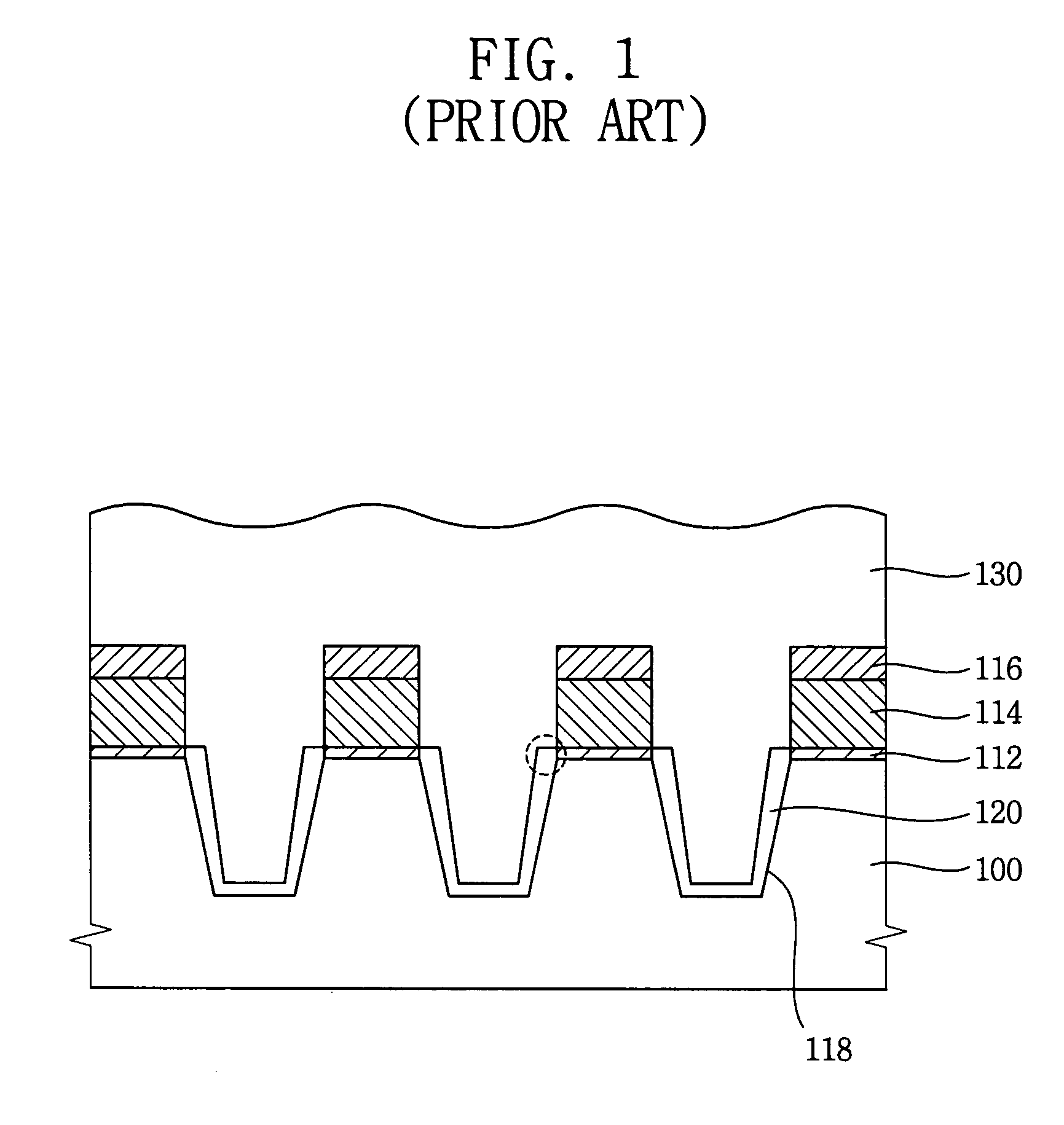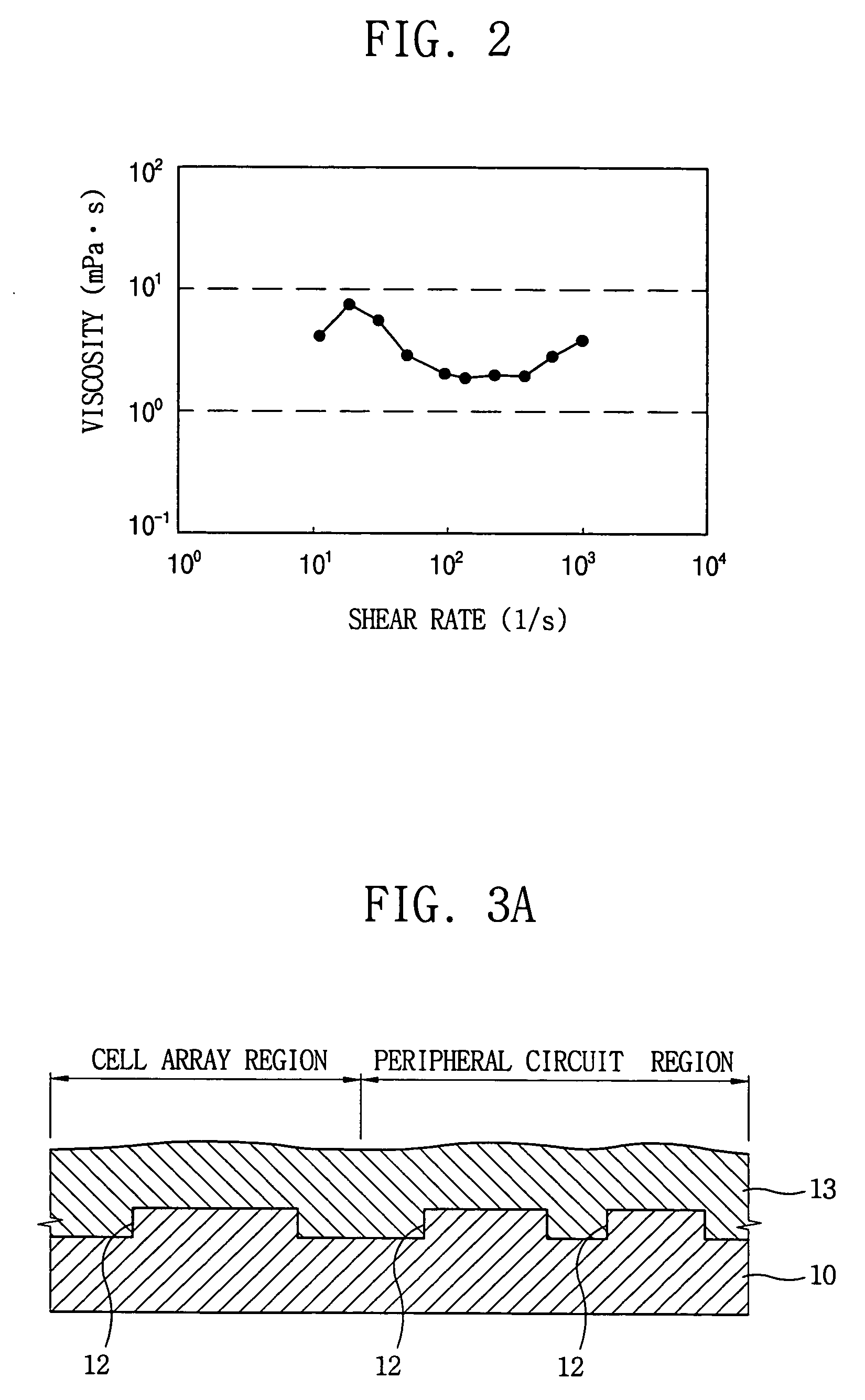Spin-on glass composition and method of forming silicon oxide layer in semiconductor manufacturing process using the same
a technology of spin-on glass and semiconductor manufacturing, which is applied in the direction of liquid/solution decomposition chemical coating, transportation and packaging, coatings, etc., can solve the problems of uneven surface of the first insulation layer, affecting the stability of the second metal layer, and increasing irregular topography of the top layer
- Summary
- Abstract
- Description
- Claims
- Application Information
AI Technical Summary
Benefits of technology
Problems solved by technology
Method used
Image
Examples
example 1
[0090]Preparation of an SOG Composition
[0091]Perhydropolysilazane having a weight average molecular weight of 4,500-7,000 and a molecular weight dispersion degree of 3.0-4.0 was obtained by fractionating commercially available perhydropolysilazane. The fractionated perhydropolysilazane was dissolved in xylene to obtain an SOG composition having a perhydropolysilazane concentration of 22-25% by weight, based on the total weight of the composition. The contact angle of the SOG composition was 4° or less with respect to an underlying silicon nitride layer.
[0092]The viscosity of the SOG composition was detected according to the variation of its shear rate. The viscosity characteristic is illustrated in FIG. 2. FIG. 2 is a graph illustrating the viscosity change with respect to the shear rate change of the SOG solution. The ordinate represents the viscosity (mPa.s) and the abscissa represents the shear rate (1 / s). As can be seen in FIG. 2, the SOG solution preferably has a uniform viscos...
example 2
[0132]Preparation of an SOG Composition
[0133]Referring to FIG. 7F, thus formed silicon oxide layer 214 was polished by a CMP method until the polishing stopping layer 204 on the semiconductor substrate 200 was exposed. Then, the inner portion of the trench 210 was buried with silicon oxide 214. Reference numeral 216 refers to a silicon oxide layer filling the trench.
[0134]Shallow Trench Isolation
[0135]When the field oxide 14 illustrated in FIG. 3 is formed to bury the trench of the highly integrated semiconductor device according to Example 1, a thick oxide layer is formed at the inner wall of the trench as illustrated in FIG. 1.
[0136]FIGS. 7A-7G are cross-sectional views for illustrating an isolating method of a shallow trench device according to further another embodiments of the present invention.
[0137]Referring to FIG. 7A, a pad oxide layer 201 having a thickness of about 100-200 Å was formed by a thermal oxidation process on a semiconductor substrate made of silicon. Then, a ni...
example 3
[0181]Preparation of an SOG Composition
[0182]Perhydropolysilazane having a weight average molecular weight of 3,000-6,000 and a molecular weight dispersion degree of 2.5-3.5 was obtained by fractionating commercially available perhydropolysilazane. The fractionated perhydropolysilazane was dissolved in xylene to obtain an SOG composition having a perhydropolysilazane concentration of 20-23% by weight, based on the total weight of the composition. The contact angle of the SOG composition was 4° or less with respect to an underlying silicon nitride layer.
[0183]The viscosity of the SOG composition was detected according to the variation of its shear rate. The SOG solution preferably has a uniform viscosity within the range of about 1.54 to 1.70 cP.
PUM
| Property | Measurement | Unit |
|---|---|---|
| viscosity | aaaaa | aaaaa |
| contact angle | aaaaa | aaaaa |
| temperature | aaaaa | aaaaa |
Abstract
Description
Claims
Application Information
 Login to View More
Login to View More - R&D
- Intellectual Property
- Life Sciences
- Materials
- Tech Scout
- Unparalleled Data Quality
- Higher Quality Content
- 60% Fewer Hallucinations
Browse by: Latest US Patents, China's latest patents, Technical Efficacy Thesaurus, Application Domain, Technology Topic, Popular Technical Reports.
© 2025 PatSnap. All rights reserved.Legal|Privacy policy|Modern Slavery Act Transparency Statement|Sitemap|About US| Contact US: help@patsnap.com



